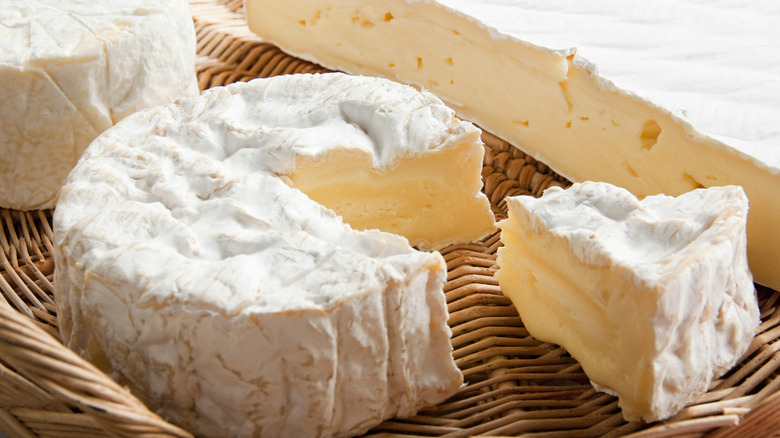The 6 Meats And Cheeses You Need For The Ultimate French Charcuterie Board
We may receive a commission on purchases made from links.
It's no secret that some of the best foods, especially wines, meats, and cheeses come from France. There are many unique ways the European Union protects its food heritage, and France has even stricter standards including AOC (Appellation d'Origine Contrôlée), which is one key standard to look for when shopping for specialist European foods. This AOC labeling ensures that French products come from a designated area, are produced in specific ways, and meet measured high-quality standards.
There are a multitude of French cheeses you need to try at least once, but putting together a France-focused charcuterie board is an easy and delicious way to start the journey. Guillaume Thivet, executive chef at Grand Brasserie in New York City, offered us suggestions for French meats and cheeses available in the U.S. to compile the ultimate French charcuterie board.
Chef Thivet emphasized the importance of varying the flavors and textures of each item, so the eating experience is more of an adventure. Some are dense like a dry sausage or hard cheese, while others are tender like a pâté or a soft, creamy brie. While these meats and cheeses are incredibly delicious on their own, you can also include sweet and savory accompaniments like grainy dijon mustard, a superior French butter like this Isigny Ste Mere beurre d'Isigny AOP, and an apricot jam. Be sure to serve crusty, fresh bread alongside everything.
Use cured meats that vary in taste and texture
There are countless type of preserved meats, so if you're in need of a refresher, check out our guide to 23 types of cured meat. While saucisson is fun to say, it simply translates to sausage in English, so it can refer to a variety of meats. Chef Guillaume Thivet recommends saucisson de Lyon specifically, which is a sausage from the foodie city of Lyon. It is a cured, dry pork sausage, although in the past it sometimes included beef, and usually contains garlic and has a coarse texture, allowing for larger pockets of tender fat to shine through.
Jambon de Bayonne is one of the best types of ham you can buy at a deli, and is made in the Bayonne region of France from specially certified pigs. You can think of it as a French version of prosciutto, as it's made in a similar fashion and has a similar salty taste and texture, which is best when thinly sliced. The ham leg is cured in a specific salt from Salies-de-Bearn, and dries for 9-12 months in the Southwest of France, giving it a slightly sweet, nutty taste, perfect for pairing with French cheeses or enjoying on its own.
Lastly, chef Thivet recommends country pâté, or pâté de campagne if you want to stick to the French. This is a chunky type of pâté usually made from liver, along with other organs and types of meat, giving it a softer texture and a more intense, iron-rich taste. The meat is combined with salt, spices, and usually an alcohol like brandy or cognac, making this the most rich and intense meat on your French charcuterie board.
Creamy, dreamy French cheeses to include
Guillaume Thivet knows how to serve and eat brie like an expert, and insists you include the classic cheese on your French cheese board. Brie is a soft cheese made from cow's milk and has a bloomy rind, which is both edible and delicious. The center of a wheel of brie is rich and velvety and, depending on how long it's aged, can become pleasingly gooey to contrast with the thicker outer rind. A young brie is mild flavored and buttery, while an aged wheel can be more tangy and pungent.
What makes comté cheese unique is its ability to pair with a wide variety of foods and beverages, as well as being delicious on its own at room temperature or melted in French onion soup or a grilled cheese sandwich. Comté is a cow's milk cheese aged anywhere between four months to over four years, and its firm texture is ideal for slicing. An aged comté has a deep, nutty, slightly sweet yet complexly satisfying flavor.
There is a romantic myth behind Roquefort cheese's origin about a shepherd wandering off after a beautiful woman and leaving his cheese in a cave, where it developed tasty mold. The imagined provenance of the creamy, pungent blue cheese only adds to the joy of eating it. The sheep's milk cheese is not for the faint of heart and is referred to as the king of cheeses by the French, due to it's rich history and tangy, sharp, and salty taste. Its striking appearance offers a contrast for your mixed French charcuterie board, as the craters from the safe-to-eat mold are so blue they're almost green in hue. Feel free to experiment with more French meats and cheeses, but do start with these six classics.


